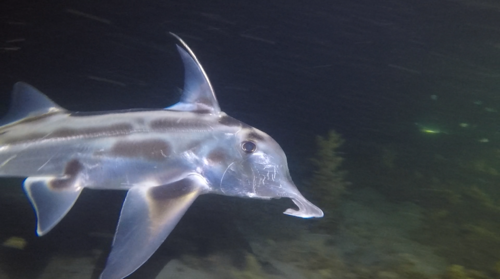
Australian Ghost Shark
The Atlantic bluefin tuna (Thunnus thynnus) is a highly migratory, large pelagic fish renowned for its size, speed, and commercial value. It is a top predator in the marine ecosystem, playing a crucial role in maintaining balance. Its warm-blooded physiology sets it apart from most other fish.
3 15 years
Lifespan
125 cm
Length
Least Concern
Conservation Status
Carnivorous
Diet
Local Migration
Migration
Appearance Overview
The Atlantic bluefin tuna is a large, streamlined fish with a metallic blue body and a silvery underside.
Color
Dark metallic blue on top, silvery underside
Body shape
Torpedo-shaped, built for speed and endurance
Fins
Two dorsal fins, the first depressible; small finlets run down the back and belly to the tail
Length
Up to 13 feet (4 meters)
Weight
Up to 2,000 lbs (907 kg)
Diet
Carnivorous, feeding on a variety of fish, squid, crustaceans, and eels.
Feeding Behavior
Highly opportunistic predators, they use their speed and agility to hunt. They often hunt cooperatively, herding and corralling prey.
Social Behavior
Forms large schools, particularly when young. Can be solitary or aggregate in smaller groups as adults, often migratory.
Commercial Relevance
Extremely high value, especially in sushi and sashimi markets, where a single fish can fetch hundreds of thousands of dollars.
Conservation measures
Subject to strict fishing quotas, seasonal closures, and minimum size limits. International agreements and monitoring programs are in place.
Status
Western Atlantic stock: Near Threatened; Eastern Atlantic and Mediterranean stock: Least Concern
Threats
Historical overfishing, bycatch in fishing gear, illegal and unreported fishing, climate change affecting prey distribution.
Habitat Distribution
Depth Range
0-3,300 feet (0-1,000 meters), though they typically spend time in the upper part of the water column.
Geographic Range
Western Atlantic: Newfoundland to the Gulf of Mexico. Eastern Atlantic and Mediterranean: Norway to the Canary Islands, including the Mediterranean Sea.
Preferred Environment
Pelagic, open ocean; prefers temperate waters but can tolerate a wide range of temperatures due to its warm-blooded nature.
Reproduction and Life Cycle
Breeding Habits
Spawns in warm waters; two main spawning grounds are the Gulf of Mexico (western stock) and the Mediterranean Sea (eastern stock). Spawning typically occurs in spring and summer.
Development Stages
Eggs are pelagic and hatch into larvae. Larvae are planktonic and undergo rapid growth. Juveniles form schools and continue to grow quickly.
Fecundity
Highly fecund; females can release up to 30 million eggs per spawning season.
Maturity Age
Western Atlantic stock: matures around 8-12 years; Eastern Atlantic and Mediterranean stock: matures around 4-5 years.
Faqs about Australian Ghost Shark
Where can you find Atlantic bluefin tuna?
Atlantic bluefin tuna are found in the Atlantic Ocean. The western population is found from Newfoundland to the Gulf of Mexico. The Eastern population ranges from Norway to the Mediterranean Sea and Canary Islands.
How long do bluefin tuna live?
They can live up to 40 years.
Are bluefin tuna still fished commercially?
Yes, but due to their high value and overfishing, strict regulations are in place to manage their populations.
How fast can a bluefin tuna swim?
They are among the fastest fish in the ocean, capable of bursts of speed up to 40-60 mph.
What is unique about bluefin tuna compared to other fish?
Unlike most fish, bluefin tuna are warm-blooded, allowing them to maintain a higher body temperature than the surrounding water, which helps with swimming speed and endurance.
What is the role of bluefin tuna in the marine ecosystem?
Bluefin tuna are apex predators and help control the populations of their prey. They are also an important part of the oceanic food web.
What are some special adaptations of bluefin tuna?
They are warm-blooded, which is rare for fish, and they can dive to depths of over 3,000 feet.
Copyright @ Nature Style Limited. All Rights Reserved.
 English
English